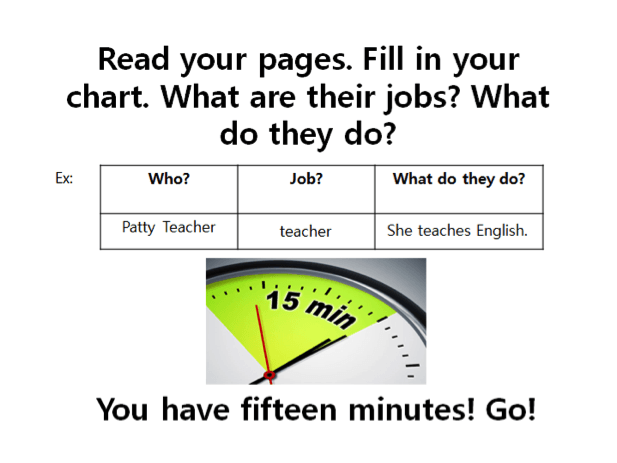As mentioned in my previous post, South Korean elementary school students do not get enough reading in their English language curriculum. One class hour—a class hour actually being forty minutes—out of every six is dedicated to reading a short contrived passage of just a few sentences, all of them carefully formulated to fit with what the students already know and are currently learning. There is nothing new or exciting in the passages or in the one or two simple comprehension questions that follow them.

In this OnTESOL graduate blog, Patricia Brooks explains how to supplement the Grade 6 Cheonjae textbook used by EPIK in South Korea.
Read More: Qualify to Teach English in South Korea with an Internationally Recognized TESOL Certification!
Using ‘Career Day’ as Authentic Reading Material
One of the lessons in the second semester of my school’s chosen sixth-grade textbook, Cheonjae Lee JaeHee, is focused on jobs and job descriptions. The lesson is titled “She is a Bag Designer,” and by the end of the lesson, students should be able to state what someone’s occupation is and describe what a person in that occupation does.
For example, students learn job-description pairs such as “She is a reporter. She writes news stories” and “My dad is a firefighter. He saves a lot of people.” The students should also be able to ask someone what another person’s job is using the pattern “What does (person’s name/title) do?”. Finally, the students should be able to ask others about their dream job (“What do you want to be?”) and answer said question when asked (“I want to be a [job name]”). There is no cultural component to this lesson as it is presented in the issued teacher guidebook.
For this lesson, I decided to make use of Anne Rockwell’s picture book “Career Day” to introduce the students not only to more job names and descriptions, but also to teach them about a part of American school culture and, most importantly, give them exposure to authentic English reading material.
Before the lesson, I first prepared the book itself to be more easily read by the students. The main concern was words that are far longer than the students had yet been exposed to (for example, “paleontologist”) and other specific, uncommon words such as “gavel.” Reading through the book in preparation for class time, I defined key vocabulary in Korean in the margins of the pages. If one of the words that I thought the students would not know was an object shown in the pictures, I simply drew a line from the word to the object.
I believe that this simple preparation was key to my students’ success. They could read the book and very quickly check the definitions of new words with just the flick of an eye to the margins, and the majority of the questions I fielded during the reading time were pronunciation questions, plus a few questions about the meanings of some of the longer sentences.
The class itself started with a review of what the students had already learned about jobs, and then an introduction of the concept of Career Day. I introduced it to the students as a fun part of elementary school life in America (and something I remember participating in as a kid!) and then asked them what kinds of special events they have at their school. In this way, they were able to, even if only briefly, think about their school life in comparison to that of students on the other side of the globe.
After introducing the cultural aspect, I gave each student a worksheet. On the worksheet was a chart with the name of each of the adults in the story on one side with spaces for the person’s job and a short description of that job to the right. Each group of four students was given a block of pages to read out loud together, filling out the chart spaces for the people presented in their pages.
When the group reading time was over, the students were numbered off into new groups so they could complete their charts in a jigsaw-type activity. In this culminating activity, the students asked a member of their group “What does (character name) do?”, using one of the key expressions of the lesson. The student to whom the question was directed would then respond, “(S)he’s a (job). (S)he (job description).” In the end, this reading time was more successful than I had anticipated.
The students worked together well, reading and understanding the book. When a lower-level student was in the group, the other group members were very supportive in helping him or her read out loud and learn new words. While every student was not able to read the entire book—this reading lesson had to fit in a single forty-minute block of time—the amount of reading the students ultimately did in that time was enough to challenge them but not overwhelm them. With careful selection of reading material and a bit of extra preparation, ESL students can succeed when given authentic material.






